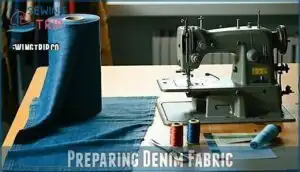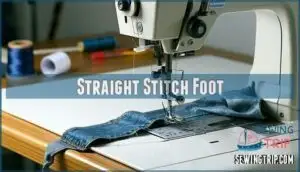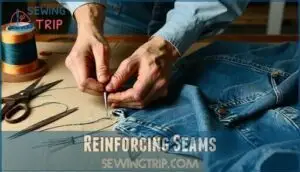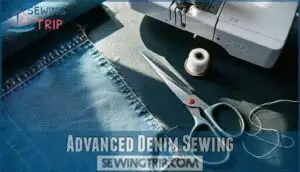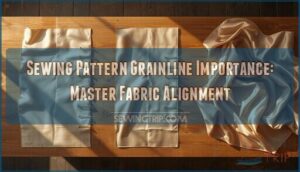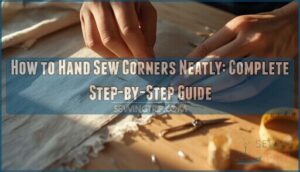This site is supported by our readers. We may earn a commission, at no cost to you, if you purchase through links.

Pre-wash your fabric to prevent shrinkage and color bleeding – trust me, nobody wants their masterpiece turning into a crop top! Use a walking foot or roller foot to feed layers evenly, and don’t rush the process.
Denim’s like that friend who needs extra patience but rewards you with lasting results. When tackling thick seams, a small hammer can flatten intersections before stitching.
The secret lies in understanding denim’s unique behavior and working with its natural characteristics rather than fighting against them.
Table Of Contents
Key Takeaways
- You’ll need heavy-duty equipment – Use size 16/100 denim needles, polyester thread, and a walking foot to handle denim’s thickness without breaking or skipping stitches.
- Pre-wash your denim fabric – Always wash before cutting to prevent 2-18% shrinkage and color bleeding that’ll ruin your finished garment’s fit and appearance.
- Adjust your machine settings – Set stitch length to 3-4mm and use straight stitches for regular denim, or zigzag stitches for stretch varieties to prevent seam failure.
- Work with denim’s natural behavior – Use patience when handling thick seams, flatten intersections before stitching, and choose appropriate fabric weights for your specific project type.
Denim Fabric Basics
You’ll love working with denim once you understand its unique properties and behavior.
This sturdy cotton twill weave has been America’s favorite fabric since the 1870s, but it requires specific techniques to achieve professional results.
Denim History and Origins
Denim’s story begins in medieval France, where craftsmen wove "serge de Nîmes" – a sturdy cotton fabric that would change fashion forever.
From medieval French looms to American workwear – denim’s journey shaped fashion history.
This French creation crossed the Atlantic, where Jacob Davis and Levi Strauss transformed it into America’s iconic workwear using traditional indigo dyeing techniques.
Here’s how denim’s French origins shaped modern sewing:
- Medieval textiles established the twill weave pattern we still use today
- Cotton trade routes brought raw materials from global markets to French mills
- Serge de Nîmes became the foundation for all modern denim fabrics
Denim Fabric Characteristics
Understanding denim’s structure helps you choose the right fabric for your project.
This sturdy cotton fabric features a distinctive twill pattern where indigo-dyed warp threads cross white weft threads, creating those diagonal ribs you’ll recognize instantly.
Considering the fabric weight factors is essential when selecting denim for your sewing projects.
| Characteristic | What It Means for You |
|---|---|
| Denim Weave | Diagonal twill pattern provides strength and flexibility |
| Fabric Weight | Measured in ounces – affects drape and difficulty |
| Yarn Dyeing | Indigo warp threads create classic fading patterns |
| Cotton Blends | Pure cotton vs. stretch blends change sewing approach |
| Twill Pattern | Creates durable fabric that softens beautifully over time |
Types of Denim Fabric
Like a closet full of options, denim fabric types offer something for every project.
Raw denim starts stiff but develops unique fades over time.
Your denim tells your story through every fade and crease.
Stretch denim blends elastane for comfort and movement.
Selvedge denim features self-finished edges and premium quality.
Organic denim uses sustainably grown cotton.
Crushed denim maintains permanent wrinkles for texture, providing a distinct texture and comfort through the use of different denim types.
Preparing Denim Fabric
Preparing your denim fabric correctly is the foundation of any successful sewing project.
You’ll want to handle prewashing, understand sanforized treatments, and master proper cutting techniques before your needle even touches the fabric.
Prewashing Denim
Raw denim demands respect before you cut the first piece. Skipping prewashing invites disaster – your perfect fit becomes a shrunken mess after the first wash.
Essential Pre Wash Tips:
- Shrinkage Control – Raw denim shrinks 2-5%, stretch varieties up to 18%
- Color Bleeding prevention – Remove 92% of excess indigo dye transfer
- Fabric Softening – Eliminate stiff sizing for easier sewing
- Denim Sanforization check – Wash three times if unsanforized for complete shrinkage release
Understanding denim pre washing techniques is vital for achieving the desired results. This denim preparation step saves heartbreak later.
Sanforized Denim
Once you’ve handled pre washing, check if your denim is sanforized.
This textile technology uses a sanforization process that pre-shrinks fabric before it reaches you.
Look for "sanforized" on the fabric bolt—it means minimal denim shrinkage after washing.
This fabric treatment saves you from surprise size changes, making your sewing projects more predictable and professional-looking.
Cutting Denim Fabric
Once you’ve completed prewashing denim, it’s time to tackle cutting.
Sharp rotary cutting tools and proper fabric layout make all the difference. Here’s your cutting game plan:
- Place denim on cutting mat with grain alignment running parallel to mat edges
- Cut lightweight denim folded; heavyweight denim should lie flat for accuracy
- Use sharp rotary cutters or fabric shears for clean, precise edges
- Mark seam allowances with water-soluble chalk before cutting
- Check grain alignment twice before making any cuts
The instructions provided are designed to improve the cutting process for denim, emphasizing the importance of sharp tools, accurate layout, and careful planning to achieve professional results.
Sewing Denim Essentials
Now that you’ve prepped your denim fabric properly, let’s talk about getting your sewing setup right.
The right denim needle selection makes all the difference – you’ll want a size 16/100 jeans needle that can punch through thick layers without breaking.
Think of it as your fabric’s best friend.
Your sewing machine settings need tweaking too; bump up that stitch length to 3-4mm for clean, strong seams.
Denim thread should be heavy-duty polyester or cotton-poly blend to match your fabric’s toughness.
Don’t forget about fabric grain alignment – it keeps your garment from twisting like a pretzel after washing.
Essential denim notions include Wonder Clips for thick sections and a walking foot to feed layers evenly.
These sewing tools turn denim stitching methods from frustrating to fantastic, setting you up for professional results every time.
Sewing Denim Techniques
Once you’ve mastered the basics of denim sewing, it’s time to tackle the specific techniques that’ll make your projects look professional.
These stitching methods will help you handle denim’s thickness and create seams that can withstand years of wear, utilizing the best techniques.
Straight Stitch Foot
Your sewing machine’s straight stitch foot becomes your best friend when tackling denim’s thick layers.
This specialized foot features a narrow opening that hugs your needle, preventing fabric from shifting during those challenging seams.
Here’s what makes it shine:
- Stitch Length – Set between 3.0-4.0mm for clean topstitching results
- Thread Tension – Increase slightly (around 4.6) for balanced stitches on heavy denim fabric
- Foot Pressure – Lower settings help bulky seams move smoothly through your machine
The foot’s groove underneath guides thick threads perfectly, while its flat base provides rock-solid fabric guidance.
You’ll notice dramatically improved seam accuracy compared to your regular zigzag foot.
Those frustrating skipped stitches? History.
Your denim sewing projects will look professionally finished every time.
For ideal results, consider using a Singer presser foot designed for fine fabrics and straight stitch sewing.
Stretch Stitch for Denim
When working with stretch denim containing elastane, you’ll need special stitches that move with the fabric.
Regular straight stitches pop under stress, ruining your project. Use a narrow zigzag or triple stitch on your sewing machines to accommodate fabric tension.
Set stitch length to 2.5-3mm and choose appropriate needle sizes (90/14).
Quality denim threads and proper topstitching prevent seam failure in stretch garments, ensuring the use of special stitches is effective.
Reinforcing Seams
Durability matters when your denim project needs to last.
Proper seam reinforcement prevents those frustrating blowouts that happen right when you’re rushing out the door.
- Flat felled seams create the strongest denim stitching by encasing raw edges completely
- Topstitching techniques with heavy-duty thread add both strength and that classic jeans look
- Strategic interfacing options at stress points like pocket corners prevent fabric tears
Note: Since there are no further concepts to group, the reorganization focuses on enhancing readability by separating the introductory sentences from the list of techniques.
Denim Care and Maintenance
Once you’ve crafted your perfect denim garment, proper care keeps it looking sharp and lasting for years.
The way you wash, dry, and iron your denim pieces can make or break their longevity and appearance.
Washing Denim Garments
Most denim garments can handle 8-10 wears before needing a wash—think of it as letting your jeans "marinate" in their character.
Cold water temperature prevents denim shrinkage and color fading, while gentle cycles protect fibers.
Turn jeans inside-out for washing denim to minimize fabric softening and preserve that crisp texture.
Skip fabric softeners during prewashing; they’ll compromise denim fabric care and durability.
Drying Denim Garments
Patience pays off in the process of drying your freshly sewn denim creations.
Skip the dryer’s high heat and hang dry your garments instead—this prevents denim shrinkage and extends fabric life.
Air drying naturally softens the material while preserving shape.
If you must use a dryer, choose low heat settings and remove while slightly damp for proper garment storage.
Using denim dryer balls can also help reduce wrinkles and soften the fabric, which is a key part of proper garment storage and maintaining the quality of your freshly sewn denim creations.
Ironing Denim Fabric
After hang-drying your denim, proper steam ironing transforms wrinkled fabric into crisp perfection.
Set your iron to cotton temperature with maximum steam application for effective denim pressing. Iron on the wrong side to protect the surface, using steady pressure for fabric smoothing.
A clapper helps flatten thick seams during denim finishing. These pressing tips guarantee professional-looking results every time.
Understanding the best iron settings is vital for achieving superior results with various fabrics, including denim, and mastering the art of denim pressing.
Denim Sewing Patterns
When selecting denim sewing patterns, you’ll want designs that work with the fabric’s natural structure and weight.
Choose patterns with clean lines and avoid overly detailed pieces that might get lost in denim’s sturdy texture, considering the fabric’s natural characteristics to ensure the best results with denim.
Choosing Suitable Designs
Three key factors guide your fabric selection when choosing denim sewing patterns.
First, match garment styles to denim weight—lightweight works for shirts and dresses, while heavyweight suits structured jackets.
Second, consider design elements like topstitching and hardware that complement denim’s natural strength.
Using Lighter Facings
When you’re working with heavyweight denim, bulk becomes your biggest enemy.
Smart sewers swap heavy denim facings for lighter cotton or cotton-poly blends. This simple switch dramatically reduces thickness at key junction points.
Here’s your facing material strategy:
- Facings Material: Choose cotton broadcloth or lightweight cotton-poly instead of matching denim
- Interfacing Tips: Use tricot interfacing that matches your denim’s stretch properties
- Fabric Reduction: Cut facings from coordinating lightweight fabric to minimize bulk
- Seam Finishing: Pink or serge facing edges before attaching to prevent fraying
- Facing Techniques: Grade seam allowances and understitch facings for crisp, flat results
This approach lets you maintain professional construction while keeping topstitching clean and manageable.
Aligning Grainlines
Perfect grainline alignment prevents twisted seams and guarantees your denim fabric hangs correctly.
Always match the pattern’s grainline arrow with the fabric’s lengthwise grain before cutting.
| Grainline Issue | Solution |
|---|---|
| Twisted seams | Double-check pattern alignment before cutting |
| Poor drape | Realign pattern pieces with fabric grain |
| Uneven hems | Use ruler to verify grainline accuracy |
Proper grainline alignment is your foundation for professional stitching denim results and seam accuracy, ensuring a well-made garment with proper drape.
Advanced Denim Sewing
You’ve mastered the basics, but advanced denim techniques will take your projects to the next level.
These specialized methods help you tackle challenging details like decorative stitching, hand-sewn repairs, and professional edge finishes that make your denim garments look store-bought.
They include skills such as professional edge finishes.
Embroidering on Denim
Embroidering on denim transforms plain garments into personalized masterpieces, but this thick fabric demands special techniques.
Use Embroidery Needles size 90/14, quality Denim Threads, and sturdy Fabric Stabilizers underneath. Denim Hoops should grip firmly without distorting fabric.
Reduce Stitch Density by 20% compared to lighter materials—dense stitching can pucker heavy denim. Machine embroidery works best with metallic threads for bold designs.
Understanding proper denim embroidery techniques is essential for achieving professional-looking results on denim fabrics.
Sewing Denim by Hand
While machine embroidery adds flair, hand stitching denim creates timeless character.
You’ll need sharp needles and strong thread for fabric handling success.
Your needle selection matters—use heavy-duty options for thick layers.
Hand stitching requires patience but delivers unmatched control over seams and hems.
Mastering denim sewing techniques is vital for achieving professional results.
Essential Hand Stitching Steps:
- Choose sturdy cotton-polyester thread that won’t snap under pressure
- Pre-punch holes with an awl to guide your needle through tough spots
- Use a thimble on your middle finger to push needles through multiple layers
- Keep stitches consistent with 8-10 per inch for professional results
- Double-stitch stress points like pocket corners and belt loops for durability
Finishing Fabric Edges
Raw denim edges need finishing to prevent fraying and achieve clean seam allowances.
Try edge binding for heavyweight fabrics or overlocking methods for stretch varieties. Hemming techniques like double-fold hems work great, while serging prevents unraveling.
For fray prevention on raw selvedge, pink the edges before construction. Your edge finishing choices affect both durability and appearance.
Frequently Asked Questions (FAQs)
Can I sew denim on my regular sewing machine?
Yes, you can sew denim on your regular machine! Use a denim needle (size 90/14 or 100/16), heavy-duty thread, and adjust to longer stitches. A walking foot helps manage thick layers smoothly.
How do I cut denim?
Tackling this tough fabric doesn’t have to be a wrestling match.
Use sharp rotary cutters or fabric scissors for clean cuts through denim’s thick weave.
Cut heavyweight denim one layer at a time for precision, while lighter weights can be cut folded.
Which thread should I use for sewing denim?
Use heavy-duty polyester or cotton-polyester thread for denim’s thickness.
Regular thread won’t handle the stress and may break.
For topstitching, choose specialized topstitching thread—it’s thicker and creates those professional-looking seams you see on quality jeans.
Which needle should I use when I sew denim?
Choose a denim needle, size 90/14 for lightweight denim or 100/16 for heavyweight fabric. These specialized needles pierce through thick layers without breaking, ensuring your machine won’t skip stitches.
Should I prewash denim?
Like skipping the rehearsal before opening night, you’ll regret not prewashing denim.
Always prewash to prevent shrinkage and color bleeding, especially with 100% cotton.
Wash separately in warm water without detergent first, to ensure the best results and avoid any potential damage, making prewash a crucial step.
What machine settings should I use when sewing denim?
Set your machine to 3-4mm stitch length with a 90/14 or 100/16 jeans needle. You’ll want polyester thread and a walking foot to handle thick layers smoothly without skipped stitches.
What is the best stitch for jean fabric?
Denim’s diagonal twill weave creates 40% stronger fabric than plain weave cotton.
You’ll want straight stitches with 0-0mm length for regular denim, but stretch denim needs zigzag or triple stitches to prevent seam breakage.
How to sew denim fabric?
Use a 90/14 or 100/16 denim needle with polyester thread.
Set your stitch length to 3-4mm and employ a walking foot for thick layers.
Press seams flat with steam for professional results.
Is denim a hard fabric to sew?
Taming denim isn’t climbing Mount Everest—it’s just a matter of using the right tools.
You’ll need heavy-duty needles, strong thread, and patience for thick seams, but it’s definitely manageable with practice.
Do you need thicker thread to sew denim?
Yes, you’ll need stronger thread for denim’s thick weave.
Heavy-duty polyester or cotton-polyester thread works best, while topstitching thread handles visible seams perfectly.
Regular thread often breaks under denim’s weight and tension.
Conclusion
Like a master blacksmith forging steel into fine tools, your journey through stitching denim fabrics advice transforms raw skills into craftsmanship.
You’ve learned that denim responds best to patience, proper preparation, and respect for its unique character.
With heavy-duty needles, walking feet, and quality thread as your allies, you’re now equipped to tackle any denim project.
Remember to pre-wash, take your time, and let those seams guide you toward professional results that’ll last for years.
- https://www.longancraft.com/blogs/sewing-tips/how-to-sew-with-denim-10-effective-tips-for-sewing-denim
- https://www.seamwork.com/fabric-guides/the-ultimate-guide-to-sewing-with-denim
- https://blog.cashmerette.com/2017/12/jeans-sewing-supplies-and-notions.html
- https://merchantandmills.com/uk/blog/denim-guide
- https://www.youtube.com/watch?v=7pbCCJLRyeM

